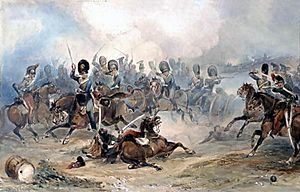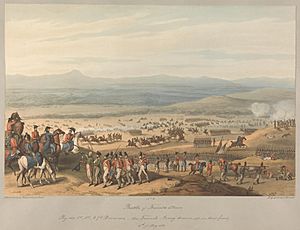Battle of Fuentes de Oñoro facts for kids
Quick facts for kids Battle of Fuentes de Oñoro |
|||||||
|---|---|---|---|---|---|---|---|
| Part of the Peninsular War | |||||||
 Captain Norman Ramsay, Royal Horse Artillery, Galloping his Troop Through the French Army to Safety at the Battle of Fuentes de Oñoro, 1811 by George Bryant Campion |
|||||||
|
|||||||
| Belligerents | |||||||
| Commanders and leaders | |||||||
| Strength | |||||||
| 33,000–36,000 infantry 1,850–2,000 cavalry 48 guns |
40,000–42,000 infantry 4,500–5,000 cavalry |
||||||
| Casualties and losses | |||||||
| 1,800 241 killed, 1,247 wounded, 312 captured |
2,700-2,844 343 killed, 2,287 wounded, 214 captured |
||||||
The Battle of Fuentes de Oñoro was a major fight during the Peninsular War. It happened from May 3 to 5, 1811. The battle was fought between the British–Portuguese Army, led by Wellington, and the French Army of Portugal, led by Marshal André Masséna.
Wellington's goal was to stop the French from helping their soldiers stuck inside the city of Almeida. The battle was a tough fight, but the British and Portuguese forces won. This victory helped Wellington keep control of Portugal and continue his plans to push the French out of Spain.
Contents
Why the Battle Happened
In 1810, the French army, led by Marshal Masséna, had chased the British and Portuguese forces back to Lisbon. However, the French couldn't get past the strong defenses known as the Lines of Torres Vedras. After a difficult winter, the French had to retreat towards the Spanish border. The British and Portuguese army followed them closely.
Wellington wanted to take back important border cities like Almeida, Badajoz, and Ciudad Rodrigo. While Wellington was trying to capture Almeida, Masséna gathered his army again. He marched to help the French soldiers trapped in Almeida.
Wellington decided to stop Masséna at a small village called Fuentes de Oñoro. He took a risk by leaving his escape route open to cover all paths to Almeida. He believed this was worth it because the French had very little food left.
- The British and Portuguese army had about 34,000 foot soldiers, 1,850 cavalry (horse soldiers), and 48 cannons.
- The French army had about 42,000 foot soldiers, 4,500 cavalry, and 38 cannons.
Who Fought in the Battle
The French Army
Marshal Masséna's army was split into four main groups, called corps, and a group of cavalry.
- Louis Henri Loison led the VI Corps.
- Jean-Andoche Junot led the VIII Corps.
- Jean-Baptiste Drouet led the IX Corps.
- Jean Reynier's II Corps was nearby, threatening Almeida.
- Louis Pierre, Count Montbrun was in charge of the main cavalry.
- A special group of 800 cavalry from the elite Imperial Guard was also there. They were led by Marshal Jean-Baptiste Bessières.
The British–Portuguese Army
Wellington commanded six groups of foot soldiers, one independent Portuguese group, and three cavalry groups.
- Important leaders included Brent Spencer (1st Division), Thomas Picton (3rd Division), William Houston (7th Division), and Robert Craufurd (Light Division).
- Stapleton Cotton led some of the cavalry.
- Edward Howorth oversaw eight artillery batteries, four British and four Portuguese.
- Some British and Portuguese forces were separate, facing the French II Corps.
The Battle Begins
On May 3, Masséna launched a direct attack on the village of Fuentes de Oñoro. British and Portuguese soldiers were defending the village, which had barricades. The French also fired heavy cannons at the British and Portuguese on the hills east of the village.
The fighting in the village was fierce all day. French soldiers fought against British soldiers from the 1st and 3rd Divisions. At first, the British and Portuguese were pushed back. But a brave charge, including men from the 71st Highland Light Infantry, helped them take back the lost streets and buildings. By the end of the day, the French pulled back, and the village remained in British hands. The French lost about 650 soldiers, while the British lost about 250.
Both sides spent May 4 resting and planning. The French found out that Wellington's right side was not well protected.
The Main Attack
The battle started again at dawn on May 5. Wellington's 7th Division was in a weak spot on his right side. Masséna launched a strong attack there, led by Montbrun's cavalry and supported by French foot soldiers. Two battalions from the 7th Division were quickly attacked by French cavalry. Wellington had to send more soldiers to save the 7th Division. The Light Division and British and German cavalry helped a lot.
The Light Division, supported by cavalry and cannons, performed a skillful fighting retreat. They covered the 7th Division's retreat to a stronger position chosen by Wellington. They lost very few soldiers. As they retreated, if French cannons came too close, the British cavalry would charge or pretend to charge. This gave the foot soldiers time to move out of range. If the French cavalry pushed the British cavalry back, the British and Portuguese foot soldiers would form squares. Their volleys of fire would then drive off the French.
Montbrun asked for help from the elite Imperial Guard cavalry, but they did not join the fight. Marshal Bessières, their commander, was not on the battlefield. Without his direct orders, the Guard cavalry refused to fight. This was a big missed chance for the French.
There were a couple of tough moments for the British and Portuguese. One British cavalry group charged a French cannon battery head-on and suffered heavy losses. Also, French cavalry caught some British soldiers in a scattered formation, causing about 100 casualties.
Masséna still wanted to capture Fuentes de Oñoro. He sent large groups of foot soldiers into the village. The village, with its low stone walls, gave good cover to the British soldiers. The narrow streets made it hard for the French. The French had some early success, but a counterattack pushed them out.
Drouet launched a second attack on the village. This time, three battalions of grenadiers led the way. The British were pushed back again. Drouet sent in more soldiers, and the French took almost the entire village.
In response, Wellington counterattacked with soldiers from the 1st and 3rd Divisions, and Portuguese soldiers. This stopped Drouet's attack, and the battle started to turn. The French were running low on ammunition and had to use their bayonets. They couldn't push the British back. Many French companies were down to only 40% of their original strength.
The French cannons tried to force the British to surrender, but Wellington's cannons were stronger. Finally, with very little ammunition left, the French attacks stopped. Wellington's men dug in for the night. After three days of showing off in front of the British, Masséna gave up and retreated. He was very angry because Bessières had refused to bring more ammunition.
What Happened After
Wellington had successfully stopped Napoleon's army. He caused many French casualties and was able to continue his blockade of Almeida. The number of losses varies, but it's estimated that 2,200 to 3,500 French soldiers were lost, compared to 1,500 to 1,800 British and Portuguese soldiers.
Wellington himself admitted that the situation was very dangerous. He later said, "If Boney had been there, we should have been beat." Some historians believe Wellington made a mistake by following the French into northern Portugal.
Two nights after Masséna left, the French soldiers trapped in Almeida (about 1,400 of them) managed to sneak past the British and Portuguese lines. About 360 French soldiers were captured, but most escaped. This was seen as a failure for the British. Wellington was very upset, writing, "I have never been so much distressed by any military event as by the escape of even a man of them."
When Masséna reached Ciudad Rodrigo, Napoleon called him back to Paris to explain what happened. Marshal Auguste Marmont took over his command. Masséna left France with a lot of gold he had taken from Portugal and Spain. He complained that Wellington had made him turn grey from stress!
During the battle, there was a sad incident where French soldiers accidentally fired on their allies, the Hanoverian Legion. The Hanoverians wore red coats, similar to the British, and in the confusion of battle, they were mistaken for the enemy. Over 100 Hanoverian soldiers died.
Wellington praised his soldiers for their kindness after the battle. He wrote that they collected money to give to the people of Fuentes de Oñoro. This was to help them pay for the damage to their homes from the fighting.
In Stories
- Cornwell, Bernard, Sharpe's Battle, HarperCollins, 1995. This book includes many events from the battle. It describes the British retreat on the right side, led by Robert Craufurd. The novel has fictional characters, but also includes real historical figures like Wellington and Masséna.
See also
 In Spanish: Batalla de Fuentes de Oñoro para niños
In Spanish: Batalla de Fuentes de Oñoro para niños


